Departments
The school has the following departments: Science, Mathematics, Design & Technology, Business and Economics, Geography, History/Government and Politics, English, Art, Modern Languages (including German, French and Spanish), Media, Information Communication Technology, Religious Education, PE and Music. The school no longer teaches Drama.
F1 in Schools
The technology department at WGSB competes in an international competition called F1 in Schools which is where students form a team of 3–6 students and then design and build a car made from a block of balsa wood (More details on F1 in Schools page). The school has taken part in this competition since the 2007–2008 season, with numerous successes.
The team Redshift succeeded the 2014 London & South-East England Regional Final and then came 3rd in the 2013 National Final at the ExCel Arena, London. This earned them the opportunity to become a collaboration team, meaning that they joined another team from around the globe – which was a team from Singapore. The team renamed from Redshift to X-Shift, a merging of both teams' names, since the Singapore team were called Team X-Treme. This meant that they took part in the 2013 World Finals held in Austin, Texas.
Another team called Turbocharged had taken part in the Bloodhound SSC class, which is the same as the F1 class but it is designing a car based around the Bloodhound SSC. The team succeeded the regional final in the 2012–13 season, and then won the national final, meaning that they were national champions and gained a new world-record time for their car racing down the track (this record was 0.587 seconds). In the 2013–14 season, the team entered again into the competition and were unsuccessful, but after lodging a complaint about other teams being illegal, meant they were able to move to the national finals as a wildcard. The team then proudly attended the national final and won it again, meaning that they are the only team that has ever become national champions twice.
For the 2015 Bloodhound SSC Class, a new team was formed called Vortex. The team consisted of three old members of Turbocharged, and a new member. Vortex did not succeed in the regionals, but were selected as a wildcard to progress to the nationals. They had the fastest time, but this was considerably slower than previous years, as the rules had changed, forcing the 8-gram car up to 30 grams. The team used the same principle of golf balls to create a turbulent boundary layer, to increase the speed of the car. The team won the national finals.
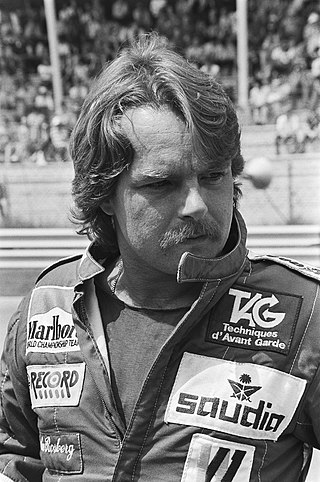
Keijo Erik Rosberg, known as "Keke", is a Finnish former racing driver and winner of the 1982 Formula One World Championship. He was the first Finnish driver to compete regularly in the series, as well as the first Finnish champion. He is the father of 2016 Formula One World Champion Nico Rosberg and is the only World Champion to see his son win the Formula One World Drivers' Championship.
The Tyrrell Racing Organisation was an auto racing team and Formula One constructor founded by Ken Tyrrell (1924–2001) which started racing in 1958 and started building its own cars in 1970. The team experienced its greatest success in the early 1970s, when it won three Drivers' Championships and one Constructors' Championship with Jackie Stewart. The team never reached such heights again, although it continued to win races through the 1970s and into the early 1980s, taking the final win for the Ford Cosworth DFV engine at Detroit in 1983. The team was bought by British American Tobacco in 1997 and completed its final season as Tyrrell in 1998. Tyrrell's legacy continues in Formula One as the Mercedes-AMG F1 team, who is Tyrrell's descendant through various sales and rebrandings via BAR, Honda and Brawn GP.

The Saturn Sky is a roadster that was produced by Saturn, and was initially released in the first quarter of 2006 as a 2007 model. It uses the Kappa automobile platform shared with the Pontiac Solstice. The Sky concept was shown at the 2005 North American International Auto Show, with the production version following at the 2006 show. It was built at GM's Wilmington Assembly plant in Wilmington, Delaware, alongside the Solstice. The Sky featured 18-inch (457 mm) wheels and a 2.4 L Ecotec LE5 inline-four engine that produced 177 hp (132 kW), a new 2.0-litre turbocharged direct injected inline-four engine that made 260 hp (194 kW) as well as an optional dealer-installed turbo upgrade kit that made 290 hp (216 kW). Both five-speed manual and automatic transmissions were available.
British racing green, or BRG, is a colour similar to Brunswick green, hunter green, forest green or moss green. It takes its name from the green international motor racing colour of the United Kingdom. This originated with the 1903 Gordon Bennett Cup, held in Ireland, as motor-racing on public roads was illegal in Great Britain. As a mark of respect, the British cars were painted shamrock green.
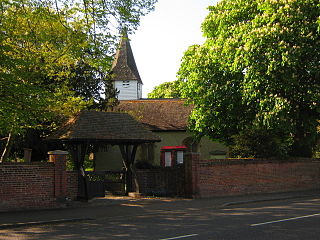
Wilmington is a village and civil parish in the Borough of Dartford in Kent, England. It is located 2.7 miles south of Dartford, 3.5 miles north of Swanley and 4.3 miles south east of Bexleyheath, adjacent to the Kent border with Greater London.

Racing flags are traditionally used in auto racing and similar motorsports to indicate track conditions and to communicate important messages to drivers. Typically, the starter, sometimes the grand marshal of a race, waves the flags atop a flag stand near the start/finish line. Track marshals are also stationed at observation posts along the race track in order to communicate both local and course-wide conditions to drivers. Alternatively, some race tracks employ lights to supplement the primary flag at the start/finish line.

The Lotus 49 was a Formula One racing car designed by Colin Chapman and Maurice Philippe for the 1967 F1 season. It was designed around the Cosworth DFV engine that would power most of the Formula One grid through the 1970s. It was one of the first F1 cars to use a stressed member engine combined with a monocoque to reduce weight, with other teams adopting the concept after its success. It also pioneered the use of aerofoils to generate downforce.
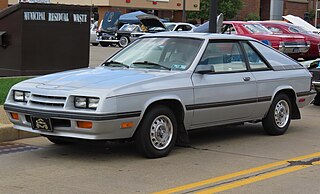
The Dodge Charger (L-body) was a subcompact 3-door hatchback/fastback built by Dodge from 1981 to 1987, and based on Chrysler's front-wheel drive L platform. A companion model, the Plymouth Turismo, was also marketed.

Dartford Grammar School for Girls is a grammar school for girls in Dartford, Kent, England. Formerly known as Dartford County School, the school opened in 1904. It is the sister school of Dartford Grammar School for Boys.

The BMW M12/13 turbo was a 1499.8 cc 4-cylinder turbocharged Formula One engine, based on the standard BMW M10 engine introduced in 1961, and powered the F1 cars of Brabham, Arrows and Benetton. Nelson Piquet won the FIA Formula One Drivers' Championship in 1983 driving a Brabham powered by the BMW M12/13 turbo. It was the first Drivers' Championship to be won using a turbocharged engine. The engine also powered the BMW GTP and in the 2.0-litre naturally-aspirated form, the successful March Engineering Formula Two cars. BMW engineers estimated the engine produced around 1,400 hp at maximum boost, however the BMW engine dynamometer could not go beyond 1,280 bhp.
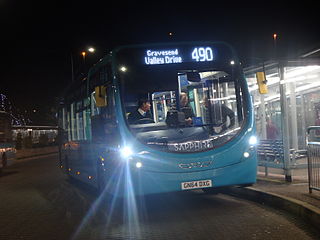
Arriva Kent Thameside Limited, trading as Arriva Kent Thameside, is a bus operator based in north-west Kent, England. It is a subsidiary of Arriva UK Bus. The company operates services in Northfleet, Gravesend & Dartford as part of the Arriva Southern Counties division from their Northfleet depot.
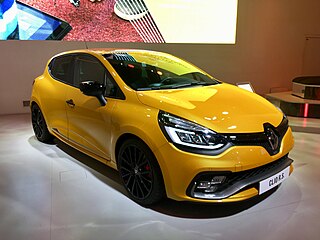
The Clio Renault Sport is a hot hatch produced by Renault Sport since 1998, the high-performance division of French automaker, Renault. It is based on the Clio supermini.

St. Bonaventure's is a Roman Catholic boys' secondary school located in the Forest Gate area in London, England. Founded in 1875, the school has a long history of providing education to boys in the local community.

F1 in Schools is an international STEM (science, technology, engineering, mathematics) competition for school children (aged 11–19), in which groups of 3–6 students have to design and manufacture a miniature car out of the official F1 Model Block using CAD/CAM design tools. The cars are powered by CO2 cartridges and are attached to a track by a nylon wire. They are timed from the moment they are launched to when they pass the finish line by a computer.

Formula One tyres play a significant role in the performance of a Formula One car. The tyres have undergone major changes throughout the history of Formula One with different manufacturers and specifications used in the sport.

The Renault RS10 was a Formula 1 car developed to compete in the 1979 Formula One season, which became the first turbocharged F1 car to win a Grand Prix. This changed the framework of F1 as this car spurred the development of the 1,300 bhp (970 kW) turbocharged cars of the 1980s and rang the death knell for normally aspirated engines. This car, along with its predecessor, the Renault RS01, was one of the most revolutionary Grand Prix cars of all time.
Bloodhound LSR, formerly Bloodhound SSC, is a British land vehicle designed to travel at supersonic speeds with the intention of setting a new world land speed record. The arrow-shaped car, under development since 2008, is powered by a jet engine and will be fitted with an additional rocket engine. The initial goal is to exceed the current speed record of 763 mph (1,228 km/h), with the vehicle believed to be able to achieve up to 1,000 miles per hour (1,609 km/h).

The Brabham BT58 was a Formula One racing car designed by John Baldwin and Sergio Rinland for the Brabham team which raced in the 1989 season. The teams cars were driven by Italian Stefano Modena and the 1988 World Sportscar Champion, the returning Martin Brundle. It made its debut at the 1989 Brazilian Grand Prix and continued until the first two races of 1990. The best result achieved was a third place at the 1989 Monaco Grand Prix driven by Modena. The car was powered by the Judd V8 engine and ran on Pirelli tyres.

The Intel AZ210, also marketed as XOLO X900 in India, Orange San Diego in the United Kingdom and Megafon Mint in Russia, is a phone manufactured by Taiwanese OEM Gigabyte for Intel.





















